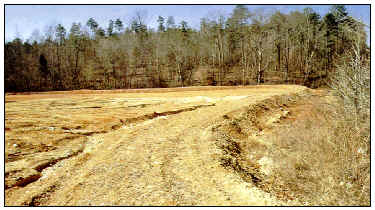
|

|
To Print Use The pdf File
ILLINOIS URBAN MANUAL
PRACTICE STANDARD
DIVERSION DIKE
(feet)
CODE 820
 (Source: NC Erosion and Sediment Control Planning and Design Manual) |
DEFINITION
A dike or dike and channel constructed along the perimeter of a disturbed construction area.
PURPOSE
The purpose of this practice is to prevent storm runoff from entering the work area or to prevent sediment-laden runoff from entering the construction site without first passing through a sediment trapping facility.
CONDITION WHERE PRACTICE APPLIES
Diversion dikes may be located at the upslope side of a construction site to prevent surface runoff from entering the disturbed area or at the downslope side of the work area to divert sediment-laden runoff to on-site sediment traps or basins. Diversion dikes do not usually encircle the entire area.
CRITERIA
Diversion dikes with 3 acres drainage area or less shall be designed using the practice standard TEMPORARY DIVERSION 955. Diversion dikes with drainage areas greater than 3 acres shall be designed using the practice standard DIVERSION 815.
CONSIDERATIONS
A diversion dike is a special application of a temporary or permanent diversion. It differs from other diversions in that the location and grade are usually fixed, and the cross section and stabilization requirements are based on the existing grade of the work boundary. Hence, the design cross section may vary significantly throughout the length. Give special care to avoid erosive velocities in steep areas. Identify areas where sedimentation will occur since they are often subject to overtopping.
Diversion dikes should be protected from damage from ongoing construction activities. At all points where diversion ridges or channels will be crossed by construction equipment, the diversion should be protected according to requirements of the practice standard STABILIZED CONSTRUCTION ENTRANCE 930. Bridges or culverts of adequate capacity may also be used.
Immediately vegetate diversion dikes after construction, but make sure channel flow area is stabilized during the initial phase of construction. Exercise caution in diverting flow to be certain that the diverted water is released through a stable outlet and that the flow will not cause flood damage. Sediment laden water should first be directed through an approved sediment-trapping device before entering receiving surface waters. Examples of acceptable sediment trapping devices include but are not limited to practice standards IMPOUNDMENT STRUCTURE-ROUTED 842, or TEMPORARY SEDIMENT TRAP 960.
PLANS AND SPECIFICATIONS
The plans and specifications for installing diversion dikes shall be in keeping with this standard and shall describe the requirements for applying the practice to achieve its intended purpose. At a minimum include the following items:
All plans shall include the installation, inspection, and maintenance schedules with the responsible party identified.
The diversion dike shall be constructed according to the requirements shown in construction specification 27 DIVERSIONS AND WATERWAYS. Standard drawing IL-515 DIVERSION PLAN may be used as the plan sheet.
OPERATION AND MAINTENANCE
Inspect diversion dikes once a week and after every rainfall. Immediately remove sediment from the flow area and repair the dike. Protect the diversion dike from construction equipment crossing.
A maintenance program shall be established to maintain diversion dike capacity, storage, ridge height, vegetation and outlet. Maintenance needs are to be discussed with the landowner or operator who is responsible for maintaining the practice. Diversion dike ridges can be hazardous for mowing. Any hazards must be brought to the attention of the responsible party.
NRCS IL February 1994